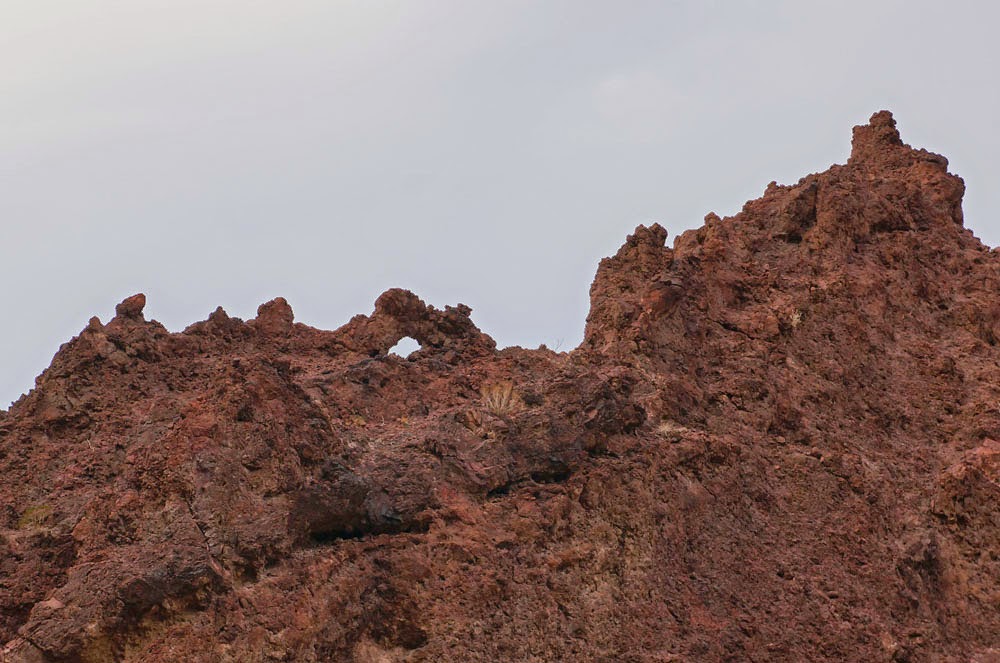
Sometime after the morning of creation, some adventurous white rocks rumbled down from newly risen Wilson Ridge. You remember the Ridge from my mentioning it on October 4, because you pay close attention to all passing comments in all the blogs and posts you read. I remembered my distant view of Wilson Ridge after reading that the strange white rocks I saw today came from there. They traveled some thirty miles and probably did it rather quickly, tumbling down a desert gorge. They made a few lazy turns with each 100-year storm, and maybe traveled a mile in each 1,000-year gully-washer. Isn’t it great to be jolted into remembrance from so long ago by something that happens today? But first, an introduction.
Calling it a trailhead implies there is a trail. But I soon learned that it’s just the way a
few people and wild burros have traveled.
I headed down White Rock Wash which would join the Colorado River. This is low elevation desert below Boulder Dam,
so vegetation is sparse and in the summer it can get very hot. Today, in the low nineties and partly shaded
within the canyon, it was pleasant.
And there I saw them—the bright white rocks, so out-of-place with dark volcanic rock all around. Strangers in a foreign land, they are no longer sharply broken as when they fell from Wilson ridge so long ago, but rounded from miles of tumbling and thumping with the push and splash of turbulent water.


And I saw conglomerate rocks in the making, along the banks of White Rock Wash. The cementing material, still soft enough to chip away with my walking stick, but in just a few thousand years, this might be another terrazzo floor. Notice the little piece of desert above the conglomerate, the way a desert often looks when we don’t see underneith it.

I walked a rocky “use trail” downstream along its bank, looking for another gulch that should enter the river on my side. (A use trail is just where people and animals have traveled. It often splits, leaving a quandary as to which way to go.) I scrambled along the steep banks of the Colorado looking for an entering watercourse which should be Hot Spring Canyon.
I came to a gulch with a small flow of water entering the Colorado. On testing its temperature with my hand, I knew it flowed from a hot spring.


Turning into the canyon, I climbed up a few little waterfalls, as the water kept getting hotter. In the narrow windless canyon, it was like walking in a sauna.

And then a deep clear pool of hot water, reminder of the earth’s hot interior that formed the pyroclastic flow. A world still hot and waiting for the signal to strike again.

From here I had two choices for getting back to the car. I could go back the way I came. Or I could use the map, which indicated a fair overland route continuing up Hot Spring Canyon, then over a ridge and back into White Rock Wash near the trailhead. I always hesitate going back via an unproven route, but this one seemed doable, and I had enough daylight to retreat if necessary. I suppose if some major problem has arisen, I would have told you. Who knows?
 |
| Keith Brantley |

I returned in time to shower before driving to Keith Brantley’s monthly Poet’s Corner at West Las Vegas Arts Center to read a few things about wilderness walks and to ask if anyone knows where Mt. Charleston is. One person did, but she had not been there.
You can enlarge any picture.
Just click on it. Then click the “back”
button to return to where you were.













I finally had the time to walk through this fascinating day with you! Yesterday I took the bellydance, haiku, dinner with Dalton, 10,000 steps, Colonnade Trail ending in Hotel Poem. I woke up this morning and found your location first thing. I feel like I put my hand in the hot stream there with you... Thank you for showing the way. I love the white rocks they remind me of the startling whiteness of Carrara marble quarries when we saw them from the train in Tuscany. And there were some of the white "extras" rocks thrown into the rivers, and creeks to help after floods there, those rocks also strartlingly white. Loved also the look of the conglomorates and your descriptions of them. And of course to finally see people! You especially! At the poetry reading!-- I knew from our call to you Friday, but to see the real proof of it, was like feeling the warmth of the hot springs or seeing those beauties of white rocks. A different kind of sauna. We are more than half way through October, so I am beginning to hear your voice in our Living Room!
ReplyDeleteI love it when people walk through dark places with me. I love their fear and knowledge of imminent death. I try to increase my love by showing the worst of it, and the likelihood of never returning. They join me and I treat them to a taste of their demise.
DeleteYou, Kathabela, are harder to convince, and remain optimistic in the face of destruction. I think that it is you who should do these things, not me.
Never been to this location. As a geology student I see an interesting display of erosion in action. Thanks for sharing it. How were the Las Vegas poets?
ReplyDelete--- Lee Collins
Most of the 40 or so people at the poetry reading were black, but the few of us honkies were not shunned or rejected. Most of the black poets recited from memory in a kind of jive or rap manner; many of them spoke harshly against the way blacks are treated.
Delete